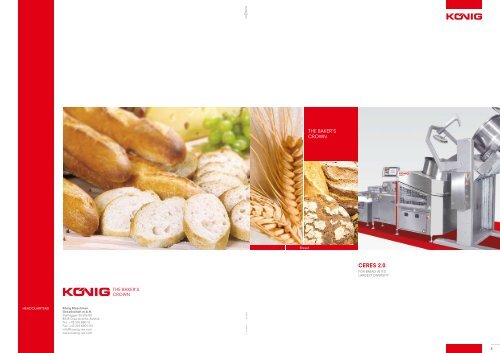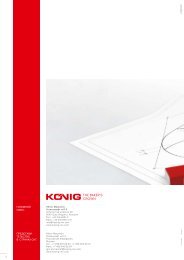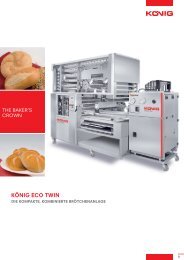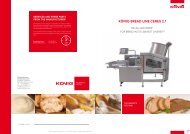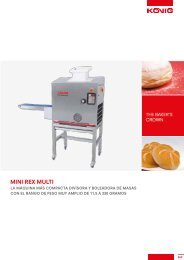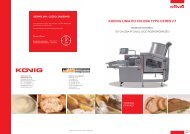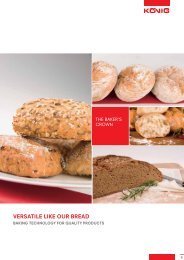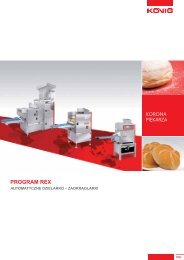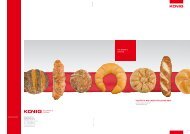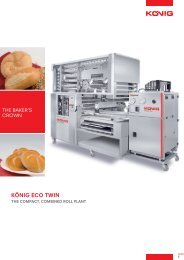CERES 2.0 - König
CERES 2.0 - König
CERES 2.0 - König
Create successful ePaper yourself
Turn your PDF publications into a flip-book with our unique Google optimized e-Paper software.
THE BAKER’S<br />
CROWN<br />
Bread<br />
<strong>CERES</strong> <strong>2.0</strong><br />
FOR BREAD IN ITS<br />
LARGEST DIVERSITY<br />
THE BAKER‘S<br />
CROWN<br />
headquaRters<br />
König Maschinen<br />
Gesellschaft m.b.H.<br />
Stattegger Straße 80<br />
8045 Graz-Andritz, Austria<br />
Tel.: +43 316.6901.0<br />
Fax: +43 316.6901.115<br />
info@koenig-rex.com<br />
www.koenig-rex.com<br />
E 148 90011 08/2007<br />
E
KÖNIG Ceres <strong>2.0</strong><br />
FOR ALL SORTS OF BREAD IN THIS WORLD.<br />
<strong>CERES</strong> <strong>2.0</strong> – THE ALL–ROUNDER.<br />
According to the knowledge of archaeologists unleavened<br />
bread was known more than 5,000 years<br />
ago, for instance in Egypt. Starting in Egypt, the art<br />
of baking bread spread to Greece and the Roman<br />
Empire and soon after captured all areas of Europe.<br />
On its way to our region many different shapes and<br />
sorts of bread developed.<br />
No matter what type of bread – wheat, rye-wheat<br />
or rye bread, Baguette or Ciabatta – today the consumer’s<br />
taste demands variety at the highest level.<br />
The baker’s challenge is to produce breads in perfect<br />
artisan quality. Ceres <strong>2.0</strong> made by König is the<br />
most technologically advanced bread-line that satisfies<br />
highest demands in terms of procedure (dough<br />
yield, bowl resting time, stress-free dough processing),<br />
accuracy, ease of cleaning and maintenance,<br />
set-up times, flexibility and product variety.<br />
The base unit consists of the bowl hoist with an integrated dough scraping device<br />
as standard as well as the patented gravitation dough dividing unit, which includes<br />
the weighing device, dividing the dough pieces absolutely gently and equally. Only<br />
by gravitation the dough is formed to a string by means of a disc, it is then discharged<br />
and weighed by a weighing belt. When the requested weight is reached,<br />
the guillotine cuts off the dough piece without any suction inside the hopper, without<br />
any pressure inside the piston and without any ejection. And if required, the<br />
proving bubbles certainly remain inside the dough.<br />
The eccentric round-moulding unit is made of a hygienic, dough-repellent material<br />
in the rounding area and gives dough pieces round shapes – as gently as the<br />
gravitation dough dividing unit does. From the eccentric round-moulding unit a<br />
transport belt transfers the dough pieces to the next processing station, for example<br />
the intermediate prover. – Due to the special design of the Ceres <strong>2.0</strong> treating<br />
the dough particularly gently, the resting process in the intermediate prover is in<br />
most cases not necessary. In this case, the dough pieces can be processed immediately,<br />
either manually or by means of a long rolling unit. A direct transfer belt<br />
can be used as an option to bypass the round moulding unit and to discharge the<br />
weighed batches in their precisely cut and angular shape.<br />
The modular design of the Ceres <strong>2.0</strong> enables the<br />
customised selection of components to meet individual<br />
needs and requirements.<br />
The era of the Ceres <strong>2.0</strong> made by König has begun.<br />
It can produce every type of bread. The reasons lie in<br />
the sophisticated technique of this line and naturally<br />
in your hands.<br />
2 3
The modules of the Ceres <strong>2.0</strong><br />
The potential of the Ceres <strong>2.0</strong><br />
Endless possibilities<br />
Bowl hoist<br />
The bowl hoist with the integrated dough scraping device automatically<br />
conveys the dough batches into the gravitation dough dividing unit.<br />
Ultimate load 700 kg.<br />
Tilting height 1,750 mm.<br />
With scraping device as standard.<br />
Gravitation dough dividing unit<br />
The weighing device of the gravitation dough dividing unit divides the<br />
dough string into equal dough pieces. As soon as the required weight of<br />
the dough pieces is reached, the guillotine cuts off the dough string.<br />
Rotating dough hopper, 300 l content, with inner cone.<br />
Rotating cutting disc.<br />
Transfer disc with duster.<br />
Dough string width 60 – 150 mm, adjustable via sensors.<br />
Electronic weighing system.<br />
1 Bowl hoist with scraping device.<br />
2 Gravitation dough dividing unit.<br />
3 Eccentric round-moulding unit.<br />
4 Take-over from weighing device.<br />
5 Guillotine.<br />
Dough yield: Flour ratio: Dough type: Hopper content: Weight range: Capacity: Connection:<br />
Multi voltage<br />
Pre-dough, direct,<br />
100% wheat up to<br />
300 – 1,200 kg/h ≈<br />
158 to 190*<br />
bowl resting time 300 l 250 – 1,800 g/pc.<br />
190 – 480 V, 50/60 Hz.,<br />
100% rye**<br />
300 – 1,500 pc./h<br />
120 min and more<br />
approx. 4 KVA<br />
* with dough divider; depending on the dough also higher dough yields possible<br />
** with dough divider; depending on the dough<br />
2<br />
3<br />
Due to the modular design of the Ceres <strong>2.0</strong> many optional units can be<br />
combined. Therefore the Ceres <strong>2.0</strong> is the all-rounder of bread production. The<br />
combination possibilities are nearly unlimited.<br />
The addition of an optional work table with a support frame for baking trays<br />
makes it possible to further process the formed and rounded dough batches<br />
manually. Alternatively, dough batches that have passed the transfer belt of the<br />
Ceres <strong>2.0</strong>, such as for Ciabatta or Baguette, can either be discharged directly<br />
by means of an adjustable transport belt with bypass device or they can be<br />
processed further.<br />
Dough pieces can be given shape and individual character by combining the<br />
Ceres <strong>2.0</strong> with different units, such as:<br />
Belt round-moulding unit for rye-wheat and rye doughs consisting of<br />
more than 60% rye.<br />
Intermediate prover.<br />
Long rolling unit.<br />
And additional units for decorating, seeding, cutting, discharging,<br />
transferring, transporting, final proving, baking, cooling, packaging, etc.<br />
1<br />
2<br />
Guillotine.<br />
Transport belt with duster.<br />
Height adjustable transfer belt.<br />
The uniqueness of the Ceres <strong>2.0</strong><br />
Eccentric round-moulding unit<br />
The dough pieces divided by the guillotine are rounded by the eccentric<br />
round-moulding unit. Due to the minimal mechanical stress the original<br />
structure of the dough remains unchanged.<br />
With duster.<br />
Transport belt with bypass for the round-moulding unit (optional)<br />
The transport belt conveys the rounded dough batches to be further<br />
processed manually or automatically. A height and length adjustable<br />
belt makes it possible to either directly remove – e.g. Ciabatta – or further<br />
process the dough pieces without the round-moulding unit – e.g.<br />
Baguettes. Naturally, the dough batches can also be transferred to an<br />
intermediate prover (not included) and/or to a long rolling unit.<br />
Work table with transport belt and support frame for baking trays<br />
(optional).<br />
1 4 5<br />
The Ceres <strong>2.0</strong> is a bread line for weighing and forming bread doughs to satisfy<br />
highest quality demands. The particular stress-free dividing and rounding<br />
procedures especially comply with all types of dough of high dough yield, long<br />
bowl resting times and to which high amounts of pre-dough are added:<br />
For all doughs with a dough yield between 158 and 190 (with dough<br />
dividing unit; depending on the dough also higher dough yields possible<br />
– trial run recommended).<br />
For all doughs ranging from 100% wheat to 100% rye (with dough dividing<br />
unit; depending on the dough – trial run recommended).<br />
For all doughs with pre-dough and long bowl resting times (possible resting<br />
time 120 min and more).<br />
One-man operation.<br />
Dough dividing unit with patented gravitation dough string technique.<br />
Hopper with 300 litre content – no pre-portioning hopper necessary.<br />
Bowl hoist with integrated scraping device to be combined directly.<br />
Sensor controlled weighing device.<br />
Hygienic materials conforming to FDA-guidelines.<br />
Nearly maintenance and wear free.<br />
Minimal cleaning efforts, shortest set up times when changing dough sorts.<br />
Siemens-S7-PLC-control with touch-panel.<br />
3<br />
1 By-passing the eccentric<br />
round-moulding device with<br />
height and length adjustable<br />
discharge belt.<br />
2 The unrounded dough<br />
batches are transported<br />
to the work table.<br />
3 Manual processing on the<br />
work table.<br />
4 Simple to open. For especially<br />
quick sort changing and easy<br />
cleaning.<br />
maximum width: 1,600<br />
unit of measurements in millimeters<br />
4 5<br />
5a<br />
4
The stress-free programme by König at a glance<br />
SFC Artisan<br />
SFR Artisan<br />
SFI Artisan<br />
Ceres <strong>2.0</strong><br />
Capacity kg per hour 400 600 1,000 1,200<br />
Bread/ bread rolls<br />
Baguette<br />
Ciabatta<br />
White bread<br />
Flat bread<br />
Rye-wheat bread<br />
Rye bread<br />
Round bread rolls<br />
Angular bread rolls<br />
Flexibility has a name:<br />
Ceres <strong>2.0</strong><br />
1<br />
possible under certain conditions<br />
3 2 4<br />
5<br />
Stress-free-competence<br />
of the market leader.<br />
What can be produced with Ceres <strong>2.0</strong><br />
Due to the possibility of producing a wide variety of breads the Ceres <strong>2.0</strong> can be<br />
called the all-rounder of the bakery. No matter what type of bread, either traditional<br />
bread such as rye bread or rye-wheat bread or typical Mediterranean bread, the<br />
Ceres <strong>2.0</strong> is the answer. Baguette, Ciabatta, white or flat bread, even pizza dough<br />
can easily be portioned with the Ceres <strong>2.0</strong>.<br />
1 Rye bread:<br />
Especially in Central and Eastern Europe rye bread is very popular. Bread made of<br />
rye flour is mellow and durable and it is characterised by a dark-coloured and tasty<br />
dough. Rich bread doughs of high dough density, such as rye bread doughs, can<br />
be easily portioned by the gravitation dough dividing unit of the Ceres <strong>2.0</strong>.<br />
2 Rye-wheat bread:<br />
Rye-wheat bread is an original bread type available in unlimited shapes and<br />
variations. The ratio between wheat and rye flour content determines the taste of<br />
the bread. The more rye flour is used, the stronger and spicier the taste. A rising<br />
proportion of wheat flour results in an increasingly light dough structure and mild<br />
taste. The integrated weighing device of the Ceres <strong>2.0</strong> divides every type of ryewheat<br />
dough equally. The doughs can also be processed by the eccentric roundmoulding<br />
unit, provided ratio of wheat exceeds 40%.<br />
3 White bread:<br />
According to the ancient Egyptians the rising lightness of wheat flour determines its<br />
nutritional value. Even today white bread ranges among the precious delicacies of the<br />
modern times. The light and mellow wheat dough is divided with minimum mechanical<br />
stress and rounded very gently by the eccentric round-moulding device of the<br />
Ceres <strong>2.0</strong>. This results in the fact that even for producing white bread in most cases no<br />
intermediate prover is needed.<br />
4 Baguette:<br />
Similar to bread itself, also the baguette is an all-rounder. According to a French legend<br />
the first baguette (“baguette” simply means “bar” in French) is said to have been baked<br />
by an Austrian baker in Paris. It is characterised by its coarse pores and crusty surface.<br />
With the Ceres <strong>2.0</strong> the dough is kept cool over a longer period of time, which results in<br />
coarse pores that are typical for the baguette.<br />
5 Ciabatta:<br />
The white bread of Italian origin based on wheat flour, yeast and water is no longer<br />
only the favourite bread of the Italians but it is also well known and popular even<br />
beyond the borders of the Mediterranean region. This cubically shaped type of bread<br />
(Italian “ciabatta” originally means: slipper, worn-out shoe, clog) differs from other<br />
wheat bread sorts because of its coarse pores. With the Ceres <strong>2.0</strong> Ciabatta can easily<br />
be produced: dividing, discharging, finished!<br />
5b<br />
6 7


